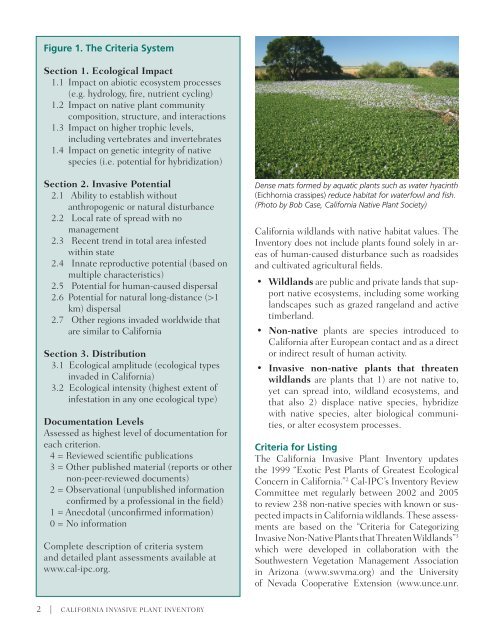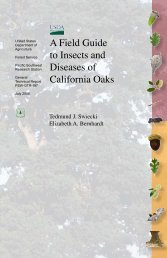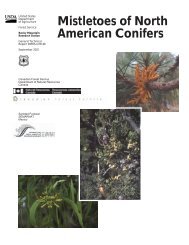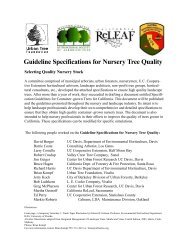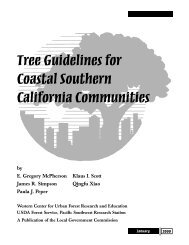2006. California Invasive Plant Inventory - Cal-IPC
2006. California Invasive Plant Inventory - Cal-IPC
2006. California Invasive Plant Inventory - Cal-IPC
Create successful ePaper yourself
Turn your PDF publications into a flip-book with our unique Google optimized e-Paper software.
Figure 1. The Criteria System<br />
Section 1. Ecological Impact<br />
1.1 Impact on abiotic ecosystem processes<br />
(e.g. hydrology, fire, nutrient cycling)<br />
1.2 Impact on native plant community<br />
composition, structure, and interactions<br />
1.3 Impact on higher trophic levels,<br />
including vertebrates and invertebrates<br />
1.4 Impact on genetic integrity of native<br />
species (i.e. potential for hybridization)<br />
Section 2. <strong>Invasive</strong> Potential<br />
2.1 Ability to establish without<br />
anthropogenic or natural disturbance<br />
2.2 Local rate of spread with no<br />
management<br />
2.3 Recent trend in total area infested<br />
within state<br />
2.4 Innate reproductive potential (based on<br />
multiple characteristics)<br />
2.5 Potential for human-caused dispersal<br />
2.6 Potential for natural long-distance (>1<br />
km) dispersal<br />
2.7 Other regions invaded worldwide that<br />
are similar to <strong><strong>Cal</strong>ifornia</strong><br />
Section 3. Distribution<br />
3.1 Ecological amplitude (ecological types<br />
invaded in <strong><strong>Cal</strong>ifornia</strong>)<br />
3.2 Ecological intensity (highest extent of<br />
infestation in any one ecological type)<br />
Documentation Levels<br />
Assessed as highest level of documentation for<br />
each criterion.<br />
4 = Reviewed scientific publications<br />
3 = Other published material (reports or other<br />
non-peer-reviewed documents)<br />
2 = Observational (unpublished information<br />
confirmed by a professional in the field)<br />
1 = Anecdotal (unconfirmed information)<br />
0 = No information<br />
Complete description of criteria system<br />
and detailed plant assessments available at<br />
www.cal-ipc.org.<br />
Dense mats formed by aquatic plants such as water hyacinth<br />
(Eichhornia crassipes) reduce habitat for waterfowl and fish.<br />
(Photo by Bob Case, <strong><strong>Cal</strong>ifornia</strong> Native <strong>Plant</strong> Society)<br />
<strong><strong>Cal</strong>ifornia</strong> wildlands with native habitat values. The<br />
<strong>Inventory</strong> does not include plants found solely in areas<br />
of human-caused disturbance such as roadsides<br />
and cultivated agricultural fields.<br />
• Wildlands are public and private lands that support<br />
native ecosystems, including some working<br />
landscapes such as grazed rangeland and active<br />
timberland.<br />
• Non-native plants are species introduced to<br />
<strong><strong>Cal</strong>ifornia</strong> after European contact and as a direct<br />
or indirect result of human activity.<br />
• <strong>Invasive</strong> non-native plants that threaten<br />
wildlands are plants that 1) are not native to,<br />
yet can spread into, wildland ecosystems, and<br />
that also 2) displace native species, hybridize<br />
with native species, alter biological communities,<br />
or alter ecosystem processes.<br />
Criteria for Listing<br />
The <strong><strong>Cal</strong>ifornia</strong> <strong>Invasive</strong> <strong>Plant</strong> <strong>Inventory</strong> updates<br />
the 1999 “Exotic Pest <strong>Plant</strong>s of Greatest Ecological<br />
Concern in <strong><strong>Cal</strong>ifornia</strong>.” 2 <strong>Cal</strong>-<strong>IPC</strong>’s <strong>Inventory</strong> Review<br />
Committee met regularly between 2002 and 2005<br />
to review 238 non-native species with known or suspected<br />
impacts in <strong><strong>Cal</strong>ifornia</strong> wildlands. These assessments<br />
are based on the “Criteria for Categorizing<br />
<strong>Invasive</strong> Non-Native <strong>Plant</strong>s that Threaten Wildlands” 3<br />
which were developed in collaboration with the<br />
Southwestern Vegetation Management Association<br />
in Arizona (www.swvma.org) and the University<br />
of Nevada Cooperative Extension (www.unce.unr.<br />
2 | CALIFORNIA INVASIVE PLANT INVENTORY


